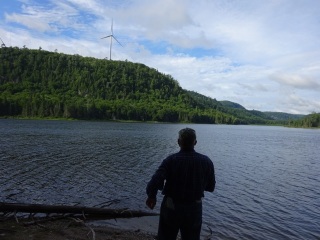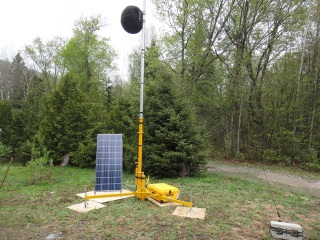It is enough to make you sick

“Unnecessary noise, then, is the most cruel absence of care which can be inflicted either on sick or well.”
Excerpted from “Chapter IV Noise” of Florence Nightingale’s famous 1898 work: “Notes on Nursing What It Is, and What It Is Not”
The World Health Organization (WHO) is in the process of updating regulatory guidelines to deal with the problem of noise pollution from industrial wind turbines (IWT) which has become more and more toxic with the proliferation industrial wind developments in quiet bucolic communities. Shockingly they are found even in remote wilderness areas where people generally have an even higher expectation of restorative tranquility. Citizens groups urge protective precaution.
The WHO has already established it is enough to make you sick:
“Residents living within 6,500 feet of a turbine feel an overall diminished quality of life. Those exposed to turbine noise at 5,000 feet also experienced significantly lower sleep quality and rated their environment as less restful. They concluded that data strongly suggests that wind turbine noise can negatively impact quality of life.”
and doctors are aware Wind Turbines aren’t good for us credit: cumberland times-news | june 29, 2016 | www.times-news.com
It has also been going on for far too long, thanks to wind industry lobbying and ideologically pre-disposed governments. Green groups, third party intervenors for the wind scam and a complicit media, have managed to help misinform the urban dwellers about the particularly odious impulsive quality of noise generated by IWT, which includes a large low frequency (LF) and infrasound (IF) component.
The Bow Lake/Nodin Kitigan industrial wind development pretty much sandwiches Jim Fata’s retreat in the wilds of Algoma, the closest of 36 1.6MW turbines being across the water at a mere 850 metres. Guests are shocked at the power of the sounds they emit which, was only supposed to be a whisper, yet can often be heard over even the small gas generator in Jim’s shed, or the radio played at moderate volume.

Aercoustics.com’s compliance monitoring tower greets those arriving by road as it stands in Jim’s little clearing with a line of sight to the turbine towers looming on the opposite shore of the small lake. The government now mandates third party monitoring of audible sound; however the devil is in the details. There is still no monitoring of Low-Frequency or Infrasound mandated and there is smoothing & minimization implicit in the “averaging” over time of the sound input; the otherwise amiable installers, who must by now be aware of all the short-comings of the rigged annoyance mitigation system, dodged any responsibility with the statement, “blame it on the government”.
We do!
Wind turbine noise testing needs a total overhaul, Wind Concerns Ontario says:
Ontario needs new wind turbine noise regulations: WCO to MOECC
Wind turbine noise testing needs total overhaul, Wind Concerns Ontario says
NEWS RELEASE
June 27, 2016, OTTAWA – Ontario needs to do a complete revision of procedures for wind turbine noise testing, Wind Concerns Ontario has informed the Ministry of Environment and Climate Change (MOECC) in a review of proposed regulatory changes.
According to WCO, the growing scientific research on wind turbine noise emissions and the escalating number of unresolved complaints confirm that proposed changes to the government’s old protocol are insufficient to address the problems faced by people living among wind turbine projects.
“The changes the Ministry has proposed to its existing procedures are nothing more than minor tweaks,” says president Jane Wilson. “The government is ignoring the need for real change to keep up with science, and to protect health from noise emissions.”
By 2015, the MOECC had received more than 2,700 complaints about problems with wind turbine noise, WCO learned. Though more recent data are not available, monitoring by WCO suggests that this number has continued to grow with the number of larger new turbines that have become operational since then.
Proposed new testing procedures are inadequate as they limit testing to audible noise outside of the home, while many citizen complaints relate to turbine noise emissions that people cannot hear, but rather, are vibrations or sensations that they feel, says WCO. And, while many complaints are about the noise and sensation experienced inside buildings, the MOECC only tests outside noise.
“The MOECC persists in the standard of using one form of noise measurement, the dBA, while the acoustics industry and even the Government of Canada has said this is providing only part of the picture on noise emissions,” Wilson says.
The process of confirming turbine compliance with regulations is convoluted and complex — people have lost trust in the Ontario government, WCO says. For example, the Enbridge project near Kincardine began operation in late 2008 but there is still no report that confirms the turbines are compliant.
The MOECC also relies on information from the power developers, and predicted modelling — not actual noise testing. This has resulted in a loss of faith in the Wynne government as a protector of public health.
Rather than dismissing resident complaints, WCO told the Ministry in a comment document in response to proposed regulatory changes, the government should view these contacts as an opportunity to learn and show leadership in responsible renewable energy implementation.
Wind Concerns Ontario is a coalition of community groups and citizens concerned about the impact of industrial-scale wind power projects on the economy, the environment, and health.
…
Contact Jane Wilson at president@windconcernsontario.caAdditional quotes:
“If government and the wind power development industry is using only A-weighted noise measurement or dBA, they are only getting part of the picture.”“Wind turbines have been found out of compliance via third-party measurements, yet the MOECC does not act on these findings. The MOECC also does not report publicly on complaints or actions taken as it does for other complaints made to the ministry ‘Spills Line’. ”
“Using only computer-generated predictive noise models does not reflect the reality of wind turbine noise emission experiences in Ontario. The Ministry of the Environment and Climate Change needs to do actual, on-site testing in conditions similar to or the same as those that spurred a citizen complaint to assure Ontarians it is fulfilling its mandate to protect people.”
See the WCO comment document filed with the Ministry of the Environment and Climate Change here: ResponsetoNoiseProtocol-June16FINAL
WIND CONCERNS ONTARIO 250 WELLINGTON MAIN STREET WELLINGTON ONTARIO
